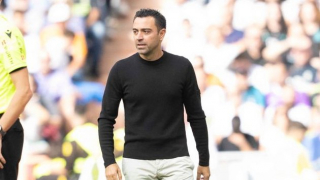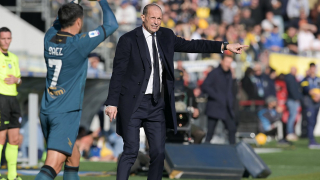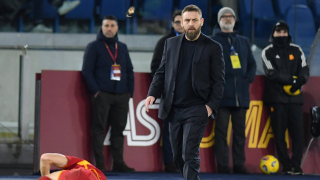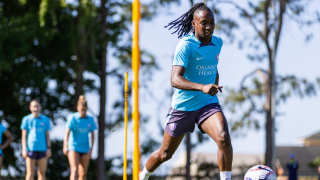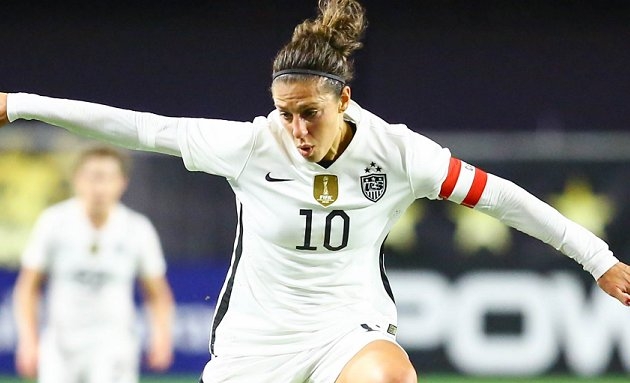This week, in our continuing series reviewing new books and writing on women's football, we turn to Mexico to discuss a new academic research article and book on the Liga MX Femenil by Daniel Anorve. We also discuss two new high profile international players who have signed with NWSL teams for the 2020 season—one from Costa Rica and the other from France.
Mexican Academic Writing and Research on Liga MX Femenil
Daniel Anorve is a professor in the Department of Political Studies at the Universidad de Guanajuato in the city of Guanajuato in Central Mexico, who is doing some wonderful research on the recent advancement of the women's game through the Mexican Liga MX Femenil. The league, each team of which is aligned with a top division men's Liga MX team, launched in the May of 2017 with the Copa MX Femenil competition followed by the Apertura (Opening Championship) from July to November 2017.He has authored an article that came out in the March 2020 edition of the academic journal Sport in Society entitled: "Gender social change, international influence and sensemaking in the launch and evolution of the Mexican professional women's football league."
Some of the key points of his fascinating article include that Mexico's second place finish at the U-17 Women's World Cup in late 2018 in Uruguay (losing a close match to Spain 2-1 in the final) was as an important validation of the importance of the Liga MX Femenil to the growth of the game in Mexico. He directly correlates that success on the world stage with the development of Liga MX Femenil, which began as primarily a U-23 league.
He also makes a clairvoyant point on the astounding attendance figures from Liga MX Femenil which has attracted attention around the world. He states that, "The Clausura 2019 (Closing Championship) average attendance was 2,685 people per game (including the playoffs)…The average attendance is well above the average of most leagues….only 6 women's leagues in the world averaged over 1,000 per game: France, Portugal, England, Spain, Italy and Kazakhstan. Meanwhile, women's football powerhouses—Germany, Norway, and Sweden—[I have tracked Sweden and Germany's league's weekly attendances for over a decade and they have hovered or surpassed 1,000 a game at times, but slipped below that benchmark in recent years]—averaged less than 1,000 spectators per game." The fully professional NWSL in the States was at a record high of 7,399 (during the regular season) in 2019. Just last month, Pumas UNAM in Mexico City held a women's game at the stadium where their men's team plays—Estadio Olimpico Universitario, where 1986 World Cup games were held—for the first time ever; UNAM drew 22,289 fans for its 0-0 tie with Cruz Azul there on March 13 (a Friday night). Grant it, despite the strong attendance figures, the Liga MX Femenil is not profitable and some teams do not charge any admission. Anorve examined this issue and found that 11 of 18 teams had an admission fee in Clausura 2019, from $20 (USD$0.85) Pesos to $100 Pesos (USD$4.30), with some clubs waiving the cost for their men's side season ticket holders.
Another positive of the Mexican women's league from Anorve's perspective was that the 2019 Cyprus Cup roster consisted of "18 players from LMXF, two playing in Spain, three in Iceland and only three Anglos." This was quite a departure from the long reliance on their American born/raised diaspora—typically half of each national team's roster, even at the youth level, came from the States over many years in order to supplant the low number of players that were coming through the Mexican grass roots' programs.
As part of his research methodology, Anorve also correlates the percentage of Mexican female athletes compared to men in the Olympic Games (in all sports dating back to 1900) to women's expanded roles in politics as women federal deputies (8.2% in 1973-76 to 49% in 2018-21) and Senators (3.3% in 1970-76 to 49% in 2018-24) as well as college undergraduate students (35% in 1980 compared with 52% in 2018). He found that, "Women accounted for only 5.5% of the Mexican Olympic Team [at the Montreal Olympics in 1976] compared with 49.41% of the Mexican team in the 2008 Beijing Olympics." Note: Mexico has qualified for only one Women's Olympic Soccer Competition, in Athens Greece in 2004 (compared to the men who won in London in 2012) but it is a smaller competition compared to the WWC, for which Mexico qualified in 1999, 2011 and 2015.
Anorve discusses the success of women's coaches in the league, thought they have been a vast minority in percentage to men's coaches, stating that "Women head coaches have been present since the birth of LMXF." Anorve points out that, despite the low percentage of league teams with women's coaches, teams coached by women have won the title, made finals and semifinal and quarterfinals in all but one tournament. He discusses a few of the better known coaches, "Eva Espejo, Pachuca's head coach, won the championship of the 2017 Cup and was also the runner-up in the title game during the Apertura 2017…. Monica Vergara, the head coach of the U-17 runner-up team…was one of the five women coaches in the Uruguay U-17 World Cup." He concludes his analysis of the female coaching impact by saying, "The sustained performances of teams coached by women at the club and national level may impact sensemaking, undoing and redoing gender roles within football."
Note: Maribel Dominguez, who is probably the best known Mexican player ever and played professionally in the U.S. in the W-League, the WUSA and NWSL as well as in Spain (including Barcelona in 2005-06) and at one point in late 2006 was prevented by FIFA from joining a men's Division 2 team in Mexico [Celaya, located in the state of Guanajuato] when she had really no other options to advance her skills in the country, is now the head coach of the U-17 Mexican national team.
Anorve also calls out some areas for the league to improve on, number one being the paltry salaries that they are paying the players, "Monthly salaries range from as low as $1500 Pesos ($80 USD) to $6,000 Pesos ($320 USD). Approximately 90% of the players make less than $6,000 ($320 USD) Pesos monthly." This is particularly scandalous as the men's league has for many decades been one of the best-paying in the Americas and even attracts top American men players, attracted to the quality of the league and pay. Teams approach to their women's side can border on the loosey-goosey side at times—Lobos BUAP and Puebla didn't start until Apertura 2018 while Cruz Azul—a major club in the heart of Mexico City next to a famous bullfighting rink—considers their women's side players to be amateurs, so they only have to cover their own expenses to play, like a youth team would in the States. Some teams provide their players with college scholarships.
Other aspects that the league needs to work on include, according to Anorve, "No cup [competition]. No awards ceremony or All Star Game, no VAR, LMXF teams may not [be promoted or relegated]. This leads to aberrational possibilities; if a men's team experiences descent to the Promotion League [Second Division], the women's team disappears, even when it may hypothetically win the title in LMFX. This ties the destiny of women's football to men's success or failure."
Anorve also states that the women's league has, "Very little revenue to offset the losses," whichshows the critical nature of raising independent funds through separate sponsorships, gate receipts and television deals for the women. These efforts will allow more name recognition to be built in the country for league and national team players. An interesting aspect that Anorve has been investigating is name recognition branding research among top women's national team players past and present—such as Kenti Robles, Maribel Dominguez and Charlyn Corral—versus the awareness levels of other sports' women athletes in Mexico.
Looking into the future, Anorve sees four distinct paths that Liga MX Femenil could follow:
1)"Fleeting league like WUSA and WPS" [professional leagues in the U.S. which both folded after their third season]. With an increase of teams playing in their main stadiums, charging admission, continuing to set attendance records, more women referees, and pride in the recent success of the U-17 Women's World Cup team, these and other positives should prevent this scenario from ever taking place.
2) "Enduring but marginal league." This is why more recognition among the general Mexican population, football fans and increasing the number of televised games (including online) is so important to avoid this fate. These improvements will drive improved salaries for players and offset the type of attitude Anorve discusses when Chivas won the Apertura 2017, their CEO Jose Luis Higuera explained the lack of prize money for players, "We do not have to talk about money. We do not have to contaminate them, the prize is this…they feel love and praised." This type of attitude will only keep salaries at a bare subsistence level and eventually drive players into other careers.
3) "A mirror of the men's league." The reasons cited for why number 1 is unlikely to happen also apply here. However, a crucial difference is that the women's league foreigners are all dual nationals—14 in total, with 13 from the U.S. and one from Argentina—compared to the men's league long being an importer of talent from all over the Americas and even other continents. Interestingly, Anorve finds that 10 of the dual-nationals play close to the U.S. border for Tijuana, Tigres or Monterrey with FC Juarez (across the river from El Paso, Texas) expected to have a few more Americans playing in 2020 and beyond. We have written before about the need for Liga MX Femenile to become a regional leader of women's soccer, by signing top players from Central America (including Costa Rica and Panama), the Caribbean and even Colombia, Ecuador and Venezuela. Currently, the league does not allow any international imports into the league, but as salaries and playing quality increase, it is a natural next step for the league to pursue.
4) "A consolidated independent, non-hyper commercialized league." It could be full "separatism, involving women's 'self-realization' by organizing their sport world independent of men; or a strategy of co-operation, establishing new negotiated sporting models. LXMF could benefit from public or community-owned media for the broadcast of games. The expansion of NGO, gender programs in universities, and transnational social movements could promote a different logic that creates an economically, socially, culturally, environmentally viable LMXF without the contradictions that are present in 'malestream' football." Separate sponsorship is vital here for a path to full independence for the women's sides, with BBVA bank's $50 million Pesos ($2,000,000 USD) sponsorship for 3 years an important start. With the women's teams in Liga MX Femenil wholly owned entities of the men's clubs organizations [just as an academy] this may be a long time goal. The FA Super League and W-League in Australia may be models to track to navigate how women's sides change their dependence on the financial, marketing and organizational aspect of men's teams. Other examples could be European super clubs who have recently added women's teams, such as Real Madrid in Spain, Juventus and Milan in Italy, and Porto in Portugal
Anorve also has a recently published book out (in Spanish only)entitled: "Liga MX Femenil: Cambios Domesticos, Influencia Internacional Y Desafio Al Al Statu Quo (Domestic Changes, International Influence and the Challenge of the Status Quo," published by Ediciones y Graficos Eon in September 2019The 173 page book focuses on the development of the Liga MX Femenil, the Mexican women's national team and brings in some new research findings.
Anorve's work follows in the footsteps of Futbolera—A History of Women & Sports in Latin America, byBrenda Elsey and Joshua Nadel, which was published by the University of Texas Press in 2019.I profiled this excellent work last year (https://www.tribalfootball.com/articles/the-week-i...). I took Fotbolera with me to France last summer when I covered the Women's World Cup, expecting it to last me through the first two weeks of the tournament; instead I read most of it on the flight to France and then finished it on my train trip to Grenoble hours after landing. The quality of research and dedication to the women's game in South America by these authors is outstanding and will drive more research and knowledge of women's football of a region that—other than for Brazil—tends to not get the focus and attention it deserves. These writers are ahead of the curve with their focus and detailed research, particularly if Brazil or Colombia is awarded hosting rights to the 2023 WWC.
Note: We analysed the 4 bid books earlier this year (https://www.tribalfootball.com/articles/the-week-in-women-s-football-breaking-down-the-2023-women-s-world-cup-bids-4312051), though a CONMEBOL hosted World Cup would not drive the revenue of either one in Japan or Australia-New Zealand—particularly in terms of sponsorships—it would further embed the women's game throughout South and Central America.
Daniel Anorve's writing is definitely something to watch and we will follow his astute analysis of what has quickly become one of the most important women's leagues in the Americas in such a short period of time. Liga MX Femenil can be a model for other countries that want to supercharge their women's football initiatives. However, the risky element is the strong link with men's clubs, which has allowed the revenue investment and infrastructure to be so quickly applied for the league to launch, but can also include a big downside in that the women's team could be ditched when things are bad, as we have seen time and again in England in the past before the launch of the Women's Super League. Just this week, the French Liga 1 men's teams have reported that they could fold if they can't conclude this season in some manner as a result of the COVID-19 situation. Many Liga I clubs have women's teams and those could also feel the fallout. We discovered last summer that all but Olympique Lyon (7.5 Million Euros), Paris St. Germain (7 Million Euros), Montpellier (3 Million Euros),Marseille (1.8 Million Euros), Reims (1.5 Million Euros) and Paris FC (1.5 Million Euros) spend less than 0.8 Million Euros on their women's sides annually, (for the 10 sides that were not relegated in the 2018-19 season). Only three teams spend 3 Million Euros or more a year in France so this will be something to monitor. Credit to Daniel Anorve for his perceptive insights and concentration on the Liga MX Femenil. We look forward to more of his writings in the seasons to come.
Costa Rican international Shirley Cruz signs with OL Reign for 2020 season.
On March 15, OL Reign in Tacoma, Washington signed veteran Costa Rican international midfielder Shirley Cruz for the 2020 season. Cruz, a long-time legend for the Costa Rican team that made the 2015 Women's World Cup in Canada, has never played in the U.S. but was a fixture for many years in France, including time under new OL Reign head coach Farid Benstiti on two occasions. Cruz joined Olympique Lyonnais in 2005, where she helped the club win six consecutive league titles and two UEFA Women's Champions League championships. In 2012, Cruz played again with Benstiti at Paris Saint-Germain, where she made 91 appearances and finished as a Champions League runner-up on two occasions. A one-year stint in China in 2018 saw Cruz win the Chinese FA Cup and the Regional Cup with Jiangsu Suning. In 2019, Cruz won the Women's First Division with Alajuelense back home. Cruz first started playing for her country in 2002 at the CONCACAF Women's Gold Cup. Most recently, Cruz made three appearances at the 2020 CONCACAF Women's Olympic Qualifying Championship, including in a narrow 1-0 loss to Canada in the semifinal.
Cruz said about her move, "The NWSL is a very competitive league, and I am very excited to be part of such a great team. I will try to do my best to achieve the goals of the team. It will be a pleasure for me, playing next to great players and a coach that knows me well and knows how to bring out the best in his players. Farid is a coach with great experience—he has won in lots of leagues, in several countries. He will demand a very technical but physical style of play. I have no doubt he will bring out the best in all of us."
Cruz's signing is a coup for OL Reign and the league, sending a message of opportunity for players from other CONCACAF nations outside of the States and Canada, and in the past Mexico before the launch of Liga MX Femenil [see more above]. I would expect Cruz to make an immediate impact with a club that is going through a coaching change and some new player additions from last season. We will discuss all of the player changes and season prospects for the 9 NWSL clubs in our annual NWSL Season Preview, ahead of the launch of this season.
French international Aminata Diallo joins the Utah Royals on a one year loan
Another international coming to the NWSL this season is French international Aminata Diallo, joining on a one year loan to the Utah Royals from Paris St. GermainThe rights to Diallo (24) were acquired from the Houston Dash in exchange for a third round draft pick for the 2021 National Women's Soccer League College Draft because Diallo was a Dash Discovery Player—someone who is a domestic or international player not currently under contract with the League. A team may claim her rights by adding her to their Discovery List (as Houston did) and retains those rights until they release them, trade them or ultimately sign them.Diallo played as a midfielder for Paris St. Germain and for the France women's national team, though she was not on France's WWC side last summer. With PSG, Diallo made 59 appearances since 2016 and in her first season she was part of the team that fell to Olympique Lyon in the championship of both the UEFA Women's Champions League and Coupe de France Féminine. Royals head coach Craig Harrington said. "We are delighted to welcome Aminata to the club. She is aggressive and quick with her movement on both sides of the ball; she is good in possession and overall makes our group stronger."
Prior to her time with PSG, Diallo played two seasons with French First Division side Guingamp (39 appearances). Additionally, she played one season with Arras—then in the First Division but now in the 32 team Second Division, which is divided into two 16 team groups—where she played in 19 matches. Diallo began her professional career with Grenoble Métropole Claix Football Féminin in 2011, at the time the club was playing in the second division of French football, where played in nearly 50 matches.
On the international stage, Diallo has appeared in seven matches for the France National Team, including during the 2018 SheBelieves Cup held in the States. She has scored one goal in seven matches. She was also a U-19 international, winning the UEFA Women's U-19 Championship and was part of the squad that finished third in the 2014 FIFA U-20 Women's World Cup.
Diallo should see more playing time in the NWSL than in Paris and Utah will receive and experienced midfielder. It is interesting to see a French player come to the NWSL and not play for OL Reign. This should be an interesting acquisition for Utah, albeit short-term. Her contract with PSG expires in 2021.
Tim Grainey is a contributor to Tribal Football. His latest book Beyond Bend it Like Beckham on the global game of women's football. Get your copy today.
Follow Tim on Twitter: @TimGrainey



